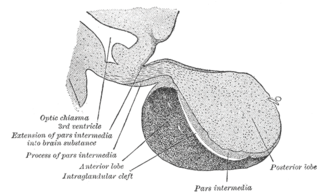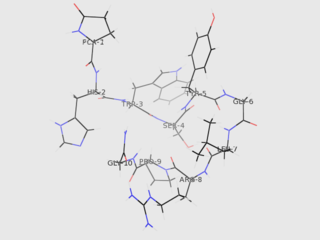Adrenocorticotropic hormone is a polypeptide tropic hormone produced by and secreted by the anterior pituitary gland. It is also used as a medication and diagnostic agent. ACTH is an important component of the hypothalamic-pituitary-adrenal axis and is often produced in response to biological stress. Its principal effects are increased production and release of cortisol by the cortex of the adrenal gland. ACTH is also related to the circadian rhythm in many organisms.

Corticotropin-releasing hormone (CRH) is a peptide hormone involved in the stress response. It is a releasing hormone that belongs to corticotropin-releasing factor family. In humans, it is encoded by the CRH gene. Its main function is the stimulation of the pituitary synthesis of ACTH, as part of the HPA Axis.

The hypothalamic–pituitary–adrenal axis is a complex set of direct influences and feedback interactions among three components: the hypothalamus, the pituitary gland, and the adrenal glands.

A major organ of the endocrine system, the anterior pituitary is the glandular, anterior lobe that together with the posterior lobe makes up the pituitary gland (hypophysis). The anterior pituitary regulates several physiological processes, including stress, growth, reproduction, and lactation. Proper functioning of the anterior pituitary and of the organs it regulates can often be ascertained via blood tests that measure hormone levels.

Cortisol is a steroid hormone, in the glucocorticoid class of hormones. When used as a medication, it is known as hydrocortisone.

Gonadotropin-releasing hormone (GnRH) is a releasing hormone responsible for the release of follicle-stimulating hormone (FSH) and luteinizing hormone (LH) from the anterior pituitary. GnRH is a tropic peptide hormone synthesized and released from GnRH neurons within the hypothalamus. The peptide belongs to gonadotropin-releasing hormone family. It constitutes the initial step in the hypothalamic–pituitary–gonadal axis.
Dynorphins (Dyn) are a class of opioid peptides that arise from the precursor protein prodynorphin. When prodynorphin is cleaved during processing by proprotein convertase 2 (PC2), multiple active peptides are released: dynorphin A, dynorphin B, and α/β-neo-endorphin. Depolarization of a neuron containing prodynorphin stimulates PC2 processing, which occurs within synaptic vesicles in the presynaptic terminal. Occasionally, prodynorphin is not fully processed, leading to the release of “big dynorphin.” “Big Dynorphin” is a 32-amino acid molecule consisting of both dynorphin A and dynorphin B.
Releasing hormones and inhibiting hormones are hormones whose main purpose is to control the release of other hormones, either by stimulating or inhibiting their release. They are also called liberins and statins (respectively), or releasing factors and inhibiting factors. The examples are hypothalamic-pituitary hormones that can be classified from several viewpoints: they are hypothalamic hormones, they are hypophysiotropic hormones, and they are tropic hormones.

Urocortin is a protein that in humans is encoded by the UCN gene. Urocortin belongs to the corticotropin-releasing factor (CRF) family of proteins which includes CRF, urotensin I, sauvagine, urocortin II and urocortin III. Urocortin is involved in the mammalian stress response, and regulates aspects of appetite and stress response.

Ursolic acid, is a pentacyclic triterpenoid identified in the epicuticular waxes of apples as early as 1920 and widely found in the peels of fruits, as well as in herbs and spices like rosemary and thyme.

Neurokinin A (NKA), formerly known as Substance K, is a neurologically active peptide translated from the pre-protachykinin gene. Neurokinin A has many excitatory effects on mammalian nervous systems and is also influential on the mammalian inflammatory and pain responses.
Neuromedin U is a neuropeptide found in the brain of humans and other mammals, which has a number of diverse functions including contraction of smooth muscle, regulation of blood pressure, pain perception, appetite, bone growth, and hormone release. It was first isolated from the spinal cord in 1985, and named after its ability to cause smooth muscle contraction in the uterus.

Corticotropin-releasing hormone receptor 1 (CRHR1) is a protein, also known as CRF1, with the latter (CRF1) now being the IUPHAR-recommended name. In humans, CRF1 is encoded by the CRHR1 gene.

Corticotropin-releasing hormone receptor 2 (CRHR2) is a protein, also known by the IUPHAR-recommended name CRF2, that is encoded by the CRHR2 gene and occurs on the surfaces of some mammalian cells. CRF2 receptors are type 2 G protein-coupled receptors for corticotropin-releasing hormone (CRH) that are resident in the plasma membranes of hormone-sensitive cells. CRH, a peptide of 41 amino acids synthesized in the hypothalamus, is the principal neuroregulator of the hypothalamic-pituitary-adrenal axis, signaling via guanine nucleotide-binding proteins (G proteins) and downstream effectors such as adenylate cyclase. The CRF2 receptor is a multi-pass membrane protein with a transmembrane domain composed of seven helices arranged in a V-shape. CRF2 receptors are activated by two structurally similar peptides, urocortin II, and urocortin III, as well as CRH.

Fibroblast growth factor 19 is a protein that in humans is encoded by the FGF19 gene. It functions as a hormone, regulating bile acid synthesis, with effects on glucose and lipid metabolism. Reduced synthesis, and blood levels, may be a factor in chronic bile acid diarrhea and in certain metabolic disorders.

Antalarmin (CP-156,181) is a drug that acts as a CRH1 antagonist.

Bakuchiol is a meroterpene in the class terpenophenol.

Verucerfont (GSK-561,679) is a drug developed by GlaxoSmithKline which acts as a CRF-1 antagonist. Corticotropin releasing factor (CRF), also known as Corticotropin releasing hormone, is an endogenous peptide hormone which is released in response to various triggers such as chronic stress, and activates the two corticotropin-releasing hormone receptors CRH-1 and CRH-2. This then triggers the release of corticotropin (ACTH), another hormone which is involved in the physiological response to stress.
Sauvagine is a neuropeptide from the corticotropin-releasing factor (CRF) family of peptides and is orthologous to the mammalian hormone, urocortin 1, and the teleost fish hormone, urotensin 1. It is 40 amino acids in length, and has the sequence XGPPISIDLSLELLRKMIEIEKQEKEKQQAANNRLLLDTI-NH2, with a pyrrolidone carboxylic acid modification at the N-terminal and amidation of the C-terminal isoleucine residue. It was originally isolated from the skin of the frog Phyllomedusa sauvagei. Given its relation to other CRF-related peptides, it exerts similar physiological effects as corticotropin-releasing hormone.
Major depressive disorder is heavily influenced by environmental and genetic factors. These factors include epigenetic modification of the genome in which there is a persistent change in gene expression without a change in the actual DNA sequence. Genetic and environmental factors can influence the genome throughout a life; however, an individual is most susceptible during childhood. Early life stresses that could lead to major depressive disorder include periodic maternal separation, child abuse, divorce, and loss. These factors can result in epigenetic marks that can alter gene expression and impact the development of key brain regions such as the hippocampus.Epigenetic factors, such as methylation, could serve as predictors for the effectiveness of certain antidepressant treatments. Currently, antidepressants can be used to stabilize moods and decrease global DNA methylation levels, but they could also be used to determine the risk of depression caused by epigenetic changes. Identifying gene with altered expression could result in new antidepressant treatments.














